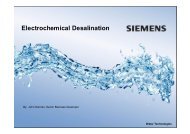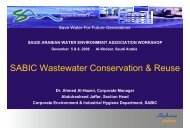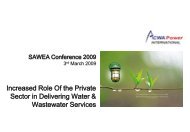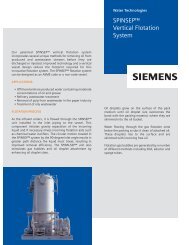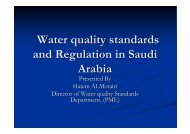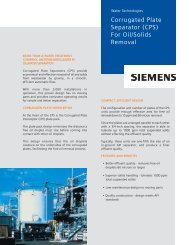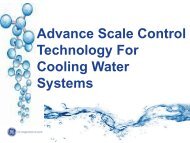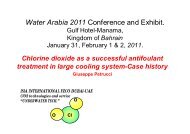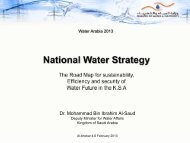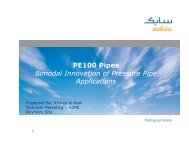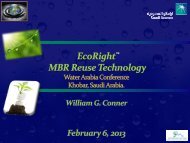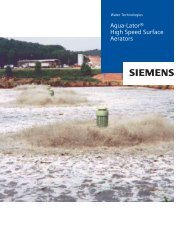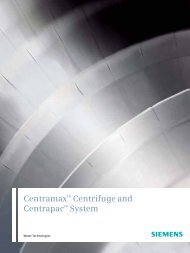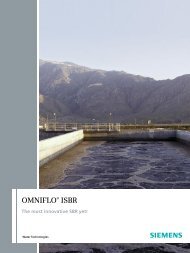state of the art waste water treatment plant with innovative solutions ...
state of the art waste water treatment plant with innovative solutions ...
state of the art waste water treatment plant with innovative solutions ...
You also want an ePaper? Increase the reach of your titles
YUMPU automatically turns print PDFs into web optimized ePapers that Google loves.
STATE OF THE ART WASTE WATER<br />
TREATMENT PLANT WITH<br />
INNOVATIVE SOLUTIONS FOR<br />
BAPCO REFINERY BAHRAIN<br />
Authors:<br />
Glen Daigger, , Si Givens, Mauro Marinetti, Carlo Zaffaroni<br />
(CH2M Hill)<br />
Savas Soydaner, David Smith, Mano Venkat, , Ali Redha<br />
Awadh, Ebrahim Mahdi (BAPCO).
Introduction<br />
Bapco identified a need to install secondary <strong>treatment</strong> to improve<br />
<strong>the</strong> quality <strong>of</strong> <strong>the</strong> <strong>waste</strong> <strong>water</strong> being discharged from <strong>the</strong> Refinery y to<br />
<strong>the</strong> Gulf.<br />
At present <strong>the</strong> <strong>waste</strong> <strong>water</strong> undergoes primary <strong>treatment</strong> in a system<br />
which consists <strong>of</strong> American Petroleum Institute (API) oil separators<br />
followed by Induced Air Flotation (IAF) units.<br />
Bapco’s <strong>waste</strong> <strong>water</strong> was considered a challenge to treat because<br />
<strong>of</strong>:<br />
– high temperature<br />
– high and variable salinity<br />
– stringent <strong>water</strong> quality regulations.<br />
Initially <strong>the</strong> use <strong>of</strong> a process based on physical-chemical chemical <strong>treatment</strong>s<br />
was considered a possibility because <strong>the</strong>re was no definitive<br />
reference in <strong>the</strong> literature to indicate that <strong>the</strong> <strong>waste</strong> <strong>water</strong> <strong>with</strong> h <strong>the</strong>se<br />
characteristics was treatable biologically.
Introduction (Cont’d)<br />
Biological secondary <strong>treatment</strong> was favored because <strong>of</strong> its lower<br />
cost.<br />
Biological secondary <strong>treatment</strong> has been common practice for a<br />
long time in Oil Refineries because <strong>of</strong> <strong>the</strong> high flow rates and <strong>the</strong> t<br />
nature and concentration <strong>of</strong> <strong>the</strong> contaminants.<br />
This presentation describes how and why <strong>the</strong> biological process<br />
technology that will be used in <strong>the</strong> new <strong>plant</strong> was selected.
Application <strong>of</strong> Waste Water Treatment<br />
Technologies Based on Flow and COD<br />
Concentration<br />
The range <strong>of</strong> different <strong>waste</strong><strong>water</strong> <strong>treatment</strong> methods<br />
1000<br />
BAPCO<br />
Waste<strong>water</strong>, m 3 /h<br />
100<br />
10<br />
1<br />
Biology<br />
Adsorption<br />
Ozone technology<br />
Wet oxidation<br />
Combustion<br />
0.1 1 10 100<br />
Chemical Oxygen Demand (COD), g/l
Discharge Specifications<br />
E ffluent spe cifications as re qu ire d by EW P<br />
Param eter<br />
G en eral Properties<br />
Un its<br />
Fin al E ffluent<br />
Sp ecification<br />
M o nthly Averag e (a )<br />
Fin al Effluent<br />
Sp ecification<br />
M axim um (b)<br />
pH - 6 to 9 N ot specified<br />
ºF<br />
∆T + 3ºC for ∆T + 3ºC for<br />
T em perature<br />
(ºC) receiving w ater receiving w ater<br />
T otal Sus pended Solids m g/l 20 35<br />
T urbidity N TU 25 75<br />
BO D m g/l 25 50<br />
C OD m g/l 150 350<br />
T otal Kjeldahl N itrogen m g/l 5 10<br />
O il and Grease m g/l 8 15<br />
Phenols m g/l 0.5 1<br />
T otal Coliform s M PN /100m l 1000 10000<br />
T OC m g/l 50 -<br />
M BAS m g/l 0.1 0.1<br />
Ino rg an ic<br />
O xygen m g/l N ot specified N ot specified<br />
Am m onia nitrogen as N m g/l 1 3<br />
Sulfide as H 2 S m g/l 0.5 1<br />
R esidual Chlorine m g/l 0.5 2<br />
C yanide as C N m g/l 0.05 0.1<br />
C hloride as NaC l m g/l N ot specified N ot specified<br />
N itrate [NO 3 ] – N m g/l N ot specified 10<br />
N itrite [NO 2 ] – N m g/l N ot specified 1<br />
T otal phosphorus m g/l 1 2<br />
M etals<br />
Aluminum m g/l 15 25<br />
Ars enic m g/l 0.1 0.5<br />
C adm ium m g/l 0.01 0.05<br />
T otal Chrom ium m g/l 0.1 1<br />
C opper m g/l 0.2 0.5<br />
Iron m g/l 5 10<br />
Lead m g/l 0.2 1<br />
M ercury m g/l 0.001 0.005<br />
N ickel m g/l 0.2 0.5<br />
Z inc m g/l 2 5<br />
1 – Discharge specification:<br />
• severe specifications on 4<br />
different nitrogen forms (TKN,<br />
N-NH 4 , N-NO 3 , N-NO 2 );<br />
• combined <strong>with</strong> specifications<br />
on organic carbon (COD, TOC,<br />
BOD);<br />
2 – Waste <strong>water</strong> (WW)<br />
composition out <strong>of</strong><br />
existing units:<br />
• high salinity<br />
• carbon nitrogen combination<br />
proper for a biological system<br />
3 - Large hydraulic flow:<br />
27,300 m 3 /d<br />
(9,950,000 m 3 /y)
First Steps<br />
It was necessary to use a fundamental approach since <strong>the</strong>re were<br />
no <strong>plant</strong>s working under similar conditions. Bapco decided to st<strong>art</strong><br />
<strong>with</strong> <strong>the</strong> basics.<br />
Samples <strong>of</strong> <strong>waste</strong> <strong>water</strong> were sent from Bapco to two independent<br />
consultants in <strong>the</strong> UK. These consultants performed bench scale<br />
treatability tests on <strong>the</strong> <strong>waste</strong> <strong>water</strong> using live activated sludge.<br />
The bench scale tests gave a good positive indication that <strong>the</strong> <strong>waste</strong> w<br />
<strong>water</strong> from <strong>the</strong> existing primary <strong>treatment</strong> is biologically treatable.<br />
The bench scale tests did not provide any firm indication regarding<br />
which biological process would be best suited.<br />
The bench scale tests did not provide enough information to develop<br />
a <strong>plant</strong> design and what information <strong>the</strong>re was, was unlikely to<br />
remain valid through scale-up.<br />
Following <strong>the</strong> bench scale tests Bapco concluded that <strong>the</strong> next step<br />
would be to conduct pilot scale tests on site in order to increase <strong>the</strong><br />
level <strong>of</strong> confidence and provide fur<strong>the</strong>r insight to <strong>the</strong> solution.
Pilot Plant<br />
A pilot <strong>plant</strong> <strong>with</strong> anoxic and aerobic biological <strong>treatment</strong> zones<br />
followed by a membrane separation stage was established on site. It<br />
was fed <strong>with</strong> <strong>water</strong> from <strong>the</strong> primary <strong>treatment</strong>.<br />
The pilot <strong>plant</strong> was operated on a continuous basis by Bapco for<br />
several months and <strong>the</strong>n for 7 months toge<strong>the</strong>r <strong>with</strong> CH2M Hill.<br />
Pilot <strong>plant</strong> operation provided a range <strong>of</strong> fundamental process<br />
information. These parameters were used as inputs into process<br />
simulation programmes in order to:<br />
– select <strong>the</strong> most appropriate <strong>treatment</strong> technology<br />
– prove that <strong>the</strong> selected technology is effective, applicable and<br />
viable.<br />
In parallel to <strong>the</strong> pilot <strong>plant</strong> operation, on-site tests, analyses and<br />
investigations were carried out to characterize <strong>the</strong> <strong>waste</strong> <strong>water</strong> and<br />
<strong>the</strong> composite streams.
Pilot Plant Flowsheet<br />
Effluent<br />
from IAF<br />
Phosphoric<br />
Acid<br />
Feed<br />
Tank<br />
1<br />
Feed<br />
Tank<br />
2<br />
Sea<br />
Water in<br />
Heat<br />
Exchanger<br />
Caustic<br />
Soda<br />
Aerobic<br />
Anoxic<br />
Acetic Spent<br />
Acid Caustic<br />
Final Effluent<br />
(permeate)<br />
Membrane<br />
Unit<br />
Sea<br />
Water out<br />
Membrane<br />
Tank Feed<br />
Waste<br />
Activated<br />
Sludge
Pilot Plant Results<br />
The Pilot Plant demonstrated that an MBR can be used to treat<br />
Bapco’s <strong>waste</strong> <strong>water</strong> and provide as complete a biological <strong>treatment</strong><br />
as possible, leaving only hard/ non-biodegradable/ recalcitrant COD<br />
and TKN un-oxidized.<br />
Additional bench scale tests were performed in a on-site laboratory,<br />
using sludge from <strong>the</strong> pilot <strong>plant</strong>, to verify <strong>the</strong> bio-kinetic constants.<br />
Fundamental process information was used as input to process<br />
simulations used to optimize <strong>the</strong> design.<br />
Reference sites in Italy were visited. These sites were using similar<br />
technology in a tightly controlled discharge environment.<br />
All <strong>of</strong> this was translated into a practical design.
Reasons for Selecting MBR<br />
Technology<br />
An MBR process, as BAT, was considered because<br />
– <strong>the</strong> low TSS limit<br />
– <strong>the</strong> low TKN limit<br />
– low sludge growth rate<br />
– low contaminant loading<br />
– Poor floc settling properties resulting from <strong>the</strong> high salinity.<br />
It was considered unlikely to meet <strong>the</strong> specs <strong>with</strong> anything o<strong>the</strong>r<br />
than an MBR.<br />
Despite rapid growth in <strong>the</strong> number <strong>of</strong> MBR installations, <strong>the</strong>y have<br />
not been used in refinery applications because <strong>of</strong> <strong>the</strong> perceived risk<br />
<strong>of</strong> membrane fouling by oil. The pilot <strong>plant</strong> demonstrated <strong>the</strong><br />
manageability <strong>of</strong> this risk.
What <strong>the</strong> WWTP will achieve for<br />
Bapco<br />
The WWT project will enable Bapco to significantly improve <strong>the</strong><br />
quality <strong>of</strong> <strong>the</strong> discharged process <strong>water</strong> and comply <strong>with</strong> <strong>the</strong><br />
environmental regulations as specified by <strong>the</strong> Bahrain Government.<br />
Currently <strong>the</strong> Best Available Technology (BAT) for <strong>the</strong> secondary<br />
biological <strong>treatment</strong> <strong>of</strong> refinery <strong>waste</strong> <strong>water</strong> would be an MBR; a<br />
biological <strong>plant</strong> (anoxic and anoxic zones) followed by a membrane<br />
separation stage.<br />
This process <strong>of</strong>fers <strong>the</strong> most complete biological <strong>treatment</strong> possible<br />
including nitrogen removal. The specification from <strong>the</strong> EWP is<br />
stringent on all forms <strong>of</strong> nitrogen.<br />
Fur<strong>the</strong>r biological <strong>treatment</strong> is not possible and as a result <strong>of</strong> this <strong>the</strong><br />
polluting nature <strong>of</strong> <strong>the</strong> treated <strong>water</strong> is at an absolute minimum. This<br />
was supported by toxicity testing.<br />
No problems <strong>with</strong> oil on <strong>the</strong> membrane or o<strong>the</strong>r issues concerning<br />
<strong>the</strong> membrane material have been encountered.
Process Configuration<br />
Currently <strong>the</strong> Best Available Technology (BAT) for <strong>the</strong> secondary<br />
biological <strong>treatment</strong> <strong>of</strong> refinery <strong>waste</strong> <strong>water</strong> would be an MBR; a<br />
biological <strong>plant</strong> (anoxic and anoxic zones) followed by a membrane<br />
separation stage.<br />
This process <strong>of</strong>fers <strong>the</strong> most complete biological <strong>treatment</strong> possible<br />
including nitrogen removal. The specification from <strong>the</strong> EWP is<br />
stringent on all forms <strong>of</strong> nitrogen.<br />
4 biological stages (anoxic/ aerobic/ anoxic/ aerobic) are necessary<br />
sary<br />
to meet <strong>the</strong> stringent specifications.<br />
Fur<strong>the</strong>r biological <strong>treatment</strong> is not possible and as a result <strong>of</strong> this <strong>the</strong><br />
polluting nature <strong>of</strong> <strong>the</strong> treated <strong>water</strong> is at an absolute minimum. This<br />
was also supported by toxicity testing.<br />
No problems <strong>with</strong> oil on <strong>the</strong> membrane or o<strong>the</strong>r issues concerning<br />
<strong>the</strong> membrane material were encountered.
Final Process Configuration<br />
The final process configuration is:<br />
– Max capacity 5000 USgpm<br />
– Unit feed pit<br />
– Equalization system<br />
– Cooling system<br />
– Integrated 4-stage 4<br />
flexible biological system (organics removal,<br />
nitrification and denitrification)<br />
– Membrane tanks for liquid/solid separation system<br />
– Sludge <strong>treatment</strong> (storage and de<strong>water</strong>ing system)<br />
– Chemical storage and dosing systems.
Spent Caustic<br />
Bapco has a <strong>waste</strong> stream <strong>of</strong> spent caustic, and ways <strong>of</strong> handling it<br />
in an environmentally acceptable way were being investigated.<br />
During <strong>the</strong> <strong>waste</strong> stream characterization it was confirmed that <strong>the</strong> t<br />
spent caustic from <strong>the</strong> refinery was problematical because <strong>of</strong> its very<br />
odorous and toxic nature.<br />
Following experiments on <strong>the</strong> pilot <strong>plant</strong> it was demonstrated that<br />
<strong>the</strong> spent caustic, when added in a controlled manner could be<br />
processed by <strong>with</strong>out a problem.<br />
The Pilot Plant mass balance showed a COD shortfall as required<br />
by <strong>the</strong> de-nitrification reaction. As an additional benefit, <strong>the</strong> spent<br />
caustic could help reduce <strong>the</strong> shortage by providing COD. This<br />
saves acetic acid addition as COD source.<br />
As ano<strong>the</strong>r benefit, <strong>the</strong> alkalinity provided by <strong>the</strong> spent caustic<br />
reduces <strong>the</strong> alkalinity required for nitrification. This saves fresh<br />
caustic addition.
Process Flowsheet<br />
Final Effluent<br />
(permeate)<br />
Spent<br />
Caustic<br />
Equalised Effluent<br />
from IAF<br />
Anoxic<br />
Nitrate Recycle<br />
Acetic acid or o<strong>the</strong>r<br />
carbon source<br />
Aerobic<br />
Anoxic<br />
Aerobic<br />
Membrane<br />
Unit<br />
Return<br />
Activated<br />
Sludge<br />
Waste<br />
Activated<br />
Sludge
Project Status<br />
The EDP has been completed.<br />
Flowsheet, P&IDs have been developed.<br />
Front End Engineering Design (FEED) has st<strong>art</strong>ed.<br />
Engineering Procurement and Construction (EPC) will<br />
follow.<br />
Options for fur<strong>the</strong>r <strong>treatment</strong> to allow <strong>water</strong> reuse are<br />
being examined.
Summary<br />
From a position <strong>of</strong> no one knowing<br />
anything about <strong>the</strong> best process, if any at<br />
all, to treat its problematic <strong>waste</strong> <strong>water</strong> and<br />
spent caustic, Bapco first established a<br />
knowledge base and <strong>the</strong>n developed that<br />
fur<strong>the</strong>r to a practical design based on an<br />
MBR, a <strong>state</strong> <strong>of</strong> <strong>the</strong> <strong>art</strong> technology.



